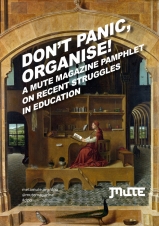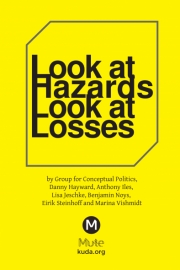No escape from theory: remarks on the movement against cuts
Interesting article from the Commune on the analogy between the current movement-in-formation against the cuts and that of the 1970s. By covering the 'State debate' and comparing social movements then and now, the author insists that at present the left is limiting itself to a critique of the cuts founded upon a dubious theory of the State, as if can be an instrument of socialism just as it has been an instrument of capitalism:
'The Left sends as a signal to the working class: ‘you folks may experience your everyday problems with jobs, debts, housing or prices in their unity – as one shitty life – but we, along with the state, will continue to channel your struggles into two separate forms and prevent you from challenging the organisation of society as a whole’.'
http://thecommune.wordpress.com/2010/08/02/no-esca...
No escape from theory: remarks on the movement against cuts02 08 2010
by Oleg Resin
The following text is just an invitation to begin collectively exploring the character of the credit-crunched state in 2010. To think that now, with cuts falling everywhere, there is no time for general discussions or to develop theory, is to artificially separate theory from action.
You can't smash the state like a bank's window...
This is an illusory idea, for each action involves theory. To rush to the streets with STOP THE CUTS banners is hardly avoiding having a theory, it is just avoiding awareness of the theoretical assumptions behind any campaign action.
‘Save Our Public Services’
The relations between the modern welfare state and the working classes are complicated and changing. The same people who in the 1960s were ‘unmasking’ the welfare state as an instrument of social control and labeled social workers as the ‘soft cops’, turned with the fiscal crisis in the 1970s into fierce defenders of welfare services. Maybe this illustrates the complicated nature of the developed state itself, maybe the lack of any useful materialist theory, maybe both. More important is that the situation repeats itself today: those who dare to criticize, for example, the NHS for the way it controls our power to judge for ourselves and organise, are quickly disciplined from our own ranks for breaking the fresh united fronts against the cuts.
So what are the characteristics of the unconscious theory behind the ‘anti-theoretical’ activism against the cuts? It is obviously based on the positions of defense of the welfare state. The labour movement in general, still now as in the 1970s, sees the welfare state in its ideal form as a kind of political representation of the working class, as an achievement which the class always had and should defend against the cruel laws of the economy. It claims that the state as it really is, has been hijacked by the capitalist class and exercises certain functions in favour of capital, e.g. subsidising private enterprises, bailing out banks, feeding army and police or intervening in the disputes between labour and capital. This concentration on the obvious links between capitalists and the government leads us to believe, that there are still some good aspects of the state, beneficial for the working class, such as free healthcare or education. So the labour movement, according to this theory prevalent in the campaigns against cuts, has to fight to maintain this good face of the state and eventually expand it, to the expense of the other, ‘ugly’, face of the state. One weakness of this argument is that it cannot explain why no labour movement anywhere in the world has managed to transform their societies to socialism in such a fashion.
So are public services ‘our services’ because they are free and satisfy some of our needs, as campaigners usually say? A functionalist version of Marxism denies these claims. It tries to show that every action of the state serves the interests of capital. From this point of view, welfare can be seen as a contribution to the productivity of a company or a national economy in a competitive environment. Employers are motivated to support a healthy, efficient and educated working class from which they can in return get more value. Whereas the state welfare’s proportion of British national income in 1860 was 1-1.5%, its share grew to 24% in 1970. Half of state expenditure in the UK went to social services in 1975. That is why political economists James O’Connor and Ian Gough spoke in 1970s about the diversification of state services in three areas. The first, social investment, covers services increasing labour productivity. The second, social consumption, represents services that subsidize the reproduction costs of labour power. And finally social expenses, which they saw as aimed at maintaining the discipline of the non-working population (e.g. social work).
The State Debate:An instrument or a form of social relations?
Let us summarize. The first account (social democratic, Labourite) sees the state as ambivalent, with the potential to be transformed into proper socialism. The second approach (revolutionary, Leninist) understands the state as determined to perform certain functions for the capitalist class and the only possible transformation is the revolutionary ‘smashing of the state’. What they both have in common is that they see the state as an instrument of class rule and relatively autonomous from the economy. In the 1970s these were no abstract theses. Both theoretical approaches informed daily actions and arguments among participants in struggles of that period (e.g. the polemics around workers’ control and workers’ plans, the ‘community politics or class struggle’ debate, ‘municipal socialisms’, the feminist ‘prefigurative’ politics, etc.). Out of these struggles but still in dialogue with the ‘hard left’, a new younger position was born, which might be called ‘the State form’ tendency. The most influential statement of this approach was probably the paper ‘Capital, Crisis and the State’, written in 1976 by John Holloway and Sol Picciotto for the Conference of Socialist Economists (CSE).
They reproached both of the above-mentioned theoretical approaches for not seeing the state in its historical context. Basing any theory of state on the remarks of Engels’ Origins of Family, Private Property and State was not useful, if we want to understand how the modern state works. It is not sufficient to declare the state to be an instrument of domination of one class over another. Such generalisation does not explain the particular character of the capitalist state. Its historically unique feature is its separation from the economy. Thus the political, the rule of law and abstract equality, stands in a contradiction to the economic area of class exploitation. The proponents of the ‘State form’ theory criticised the functionalists for taking the fact of an external state ‘intervening in the economy’ for granted. This is historically unfounded since a feudal or any earlier type of state appeared to the lower classes as a unified oppressive force, integrating both economic and political moments. The economic and political position of any person in the feudal pyramid was identical. Only the development of capital as a social relationship, embodied in the free sale of labour power as a commodity, brings about the separation of the political sphere from the economic. Why? The sale and purchase of labour power has got a double character. On one hand, it is direct exploitation, violence of one class over the other. On the other hand, it is a free contract of commodity exchange, one of them being labour power. This voluntary contractual aspect is crucial, without it no sale of working time and production of capitalist value would be possible, hence no capitalism.
This makes the capitalist form of class exploitation different from the previous ones. While a feudal lord disposed of both the ‘economic’ and ‘legal’ power to keep the serf fixed to his piece of land (to maintain the reproduction of the social classes), a capitalist does not need to force a worker to stay in the job. The abstract character of labour allows for a free labour turnover. In cases when workers question their social position as a class (social reproduction is threatened) such as in strikes, road blockades or mass avoidance of work, the capitalists have ‘subcontracted’ the dirty use of violence to an external institution – the state. The existence of the state as an external rule of law is thus dependent on the capital relation and the reproduction of the state depends on the reproduction of the capital relation. With the abolition of wage labour and thus capital, the external ‘above our heads’ state ceases to exist.
From the fact that the state is essential for the production and reproduction of capital as a social relation (via the guarantee and supervision of the contract), Holloway and Picciotto took an innovative step and proclaimed that the state is a form of social relations too. They built on Marx’s unique approach to classical categories of political economy (capital, money, wage, credit, rent, etc.) which saw them as fetishized separate objects and at the same time as internally connected forms of social relationships.‘The process of capitalist production gives rise to formations, in which the vein of internal connections is increasingly lost, the production relations are rendered independent of one another and the component values become ossified into forms independent of one another’ (Capital, Vol. III, p. 828)
Like other social forms, the state too exists in its double dimension – as a social form and as a fetishized thing (the state apparatus) at the same time.
In and Against the State
In 1979 one CSE study group published the book ‘In and Against the State’ which elaborated an anti-State theory down to the level of strategies and real experiences of state workers and their clients. Community groups, service users, tenants, trade unions, etc. in the UK at that time were demanding various forms of state intervention. The most common demands were to improve social service provision (homeless, youth, access to council housing, etc.) and to stop bureaucratic or humiliating forms of the existing provision such as housing waiting lists, means-testing, delays in benefits, non-cohabitation rules for single mothers, etc. Community and social workers were among those best placed to see how any State-lead solutions actually deepened working class dependency on the state. For example new legal advice centres had been opened on estates but the casework form of state intervention was fragmenting the response of working class people into following individual procedures. Radical community workers were often instrumental in this. How to be an anti-capitalist directly at work, if you are a teacher, nurse, social or community worker employed by the state?
‘In and Against the State’ creatively assimilated the dual perspective of the state as a social form and an apparatus (‘the fossil of previous class struggles’): ‘The problem of working in and against the State is precisely the problem of turning our routine contact with the State apparatus against the form of social relations which the apparatus is trying to impose upon our actions.’ The welfare state is seen not as a meta-structure imposing external constraints on our agency, but as a flexible result of constant class struggle, of everyday state activity as well as activity of the working class in general and state workers in particular. The state apparatus as a flow of state activity constantly divides the working class by imposing state definitions and multiple cross-class identities (citizen, worker, receiver of benefits, voter, tax payer, service user, pensioner, etc.). They proposed oppositional strategies for state workers: overcoming individualisation, rejecting misleading categories, defending ourselves in class terms, defining our problem our way, stepping outside the brief, rejecting managerial priorities, alternative organisation in struggle. Again, no chance to go into more detail here!
Conclusions
The movement against the cuts, which is now just beginning, seems to be built on a very similar model as the movement against the cuts in the 1970s (culminating in an 80,000 strong mass lobby of Parliament on 17th November 1976). The earlier movement was defeated (£3bn of cuts announced in December 1976). The present movement is even more fragmented and the numbers of activists are much smaller, so why should the outcome be different?
Apart from the numbers’ issue, the typical demands coming from the Left are surprisingly limited: taxing financial transactions, nationalisation, workers’ control over banks and the strategic economy, support for productive capital, protectionism, cutting military budgets, green jobs, the cooperative or social economy, etc. I see the major weakness of these demands in the fact that they remain within the state and they are dependent on the capitalist state. They affirm the state and the division between the political and the economic. If we take the separation ‘politics/economics’ or ‘private/public’ (‘base/superstructure’ model) as our starting underlying assumption, we impose limits on our future resistance. So we constrain ourselves within the limits of state and the production of value. We are losing sight of any communist tendency in the material struggle against the changing state. The Left sends as a signal to the working class: ‘you folks may experience your everyday problems with jobs, debts, housing or prices in their unity – as one shitty life – but we, along with the state, will continue to channel your struggles into two separate forms and prevent you from challenging the organisation of society as a whole’.
Seeing the state as a form of social relations means that its development can be grasped only as a moment of a development of the totality of social relations, with their core centred in the changing mode of production. This might help to understand the apparent paradoxes of the austerity regimes: Why does the local state in the Wirral want to save £8 milion on service provision but is going to invest £20 milion in new buildings providing centralised and more automated services? What about the similar paradox in the Royal Mail? If the state is seen not as an agent of this broader restructuring (thus a target that can be pushed or replaced by the popular mobilisation) but as its necessary part and precondition, we start to pose a deeper question of a movement against restructuring, against commodification of our social relations as such. Such a perspective allows us to see real material links between state workers and private sector workers, between the productive and service sectors, much better than the rhetorical expressions of solidarity between the fragmented unions.
It’s not easy to say what the role of communists in the present limited movement should be. I think that some of the questions and conclusions of the above mentioned State Debate from the 1970s provide a useful theoretical framework that might help to avoid the political trap of the minimum consensus programmes – defend the services, join the union, …(Of course, the state changed massively within the last 30 years, especially under the New Labour: the even more perfect integration of trade unions, new divisions inside the working class, new services and needs covered by the state, insertion of capital circuits into the service provision, workfare programmes, etc. What are the exact changes and their implications for the struggle against the austerity regimes?) As I have tried to show, Holloway and Picciotto saw the state as a form of the social relations of capital. This approach allows us to see the state above society as a historical, temporary relation, conditioned by the existence of capital. It provides our subjective desires for living in a society without oppression with a solid materialist theory.
But why should a society without state and classes be desirable for everybody living from their own work? In the UK people have been shaped by the ‘good’ old days of the welfare state. They still remember it and if pushed to choose between a communist experiment or the stability of the old days, the decision would be obvious. However, the crisis in 2010 is different from 1979 and the ‘C’ word has more meanings today. Whilst the idea of a return to the welfare society might be very common, it seems an unlikely option for the world organised by capital. As Sander from Internationalist Perspective points out, the austerity measures will just increase productive overcapacity worldwide, only pushing capital into more speculation again, into new financial bubbles, new debts and more austerity again. He thinks that one survival measure for capital will be to raise profits by lowering wages. This means increasing the numbers of working class across the world, creating an oversupply of labour power on the world market and pushing wages under the value of labour power. ‘The fact that paying wages under the value of labour power destroys labour power is not a limit when that labour power is abundant. As any overproduced commodity, labour power must devalorise. This cannot be resisted from within the logic of capital. Resisting thus becomes in practice refusing to be a commodity, rejecting the value-form.’
I like his approach for it connects a pessimistic analysis of the crisis with an argument for communism. It is put forward as a material necessity rather than previous well-known appeals to the ‘dialectical’ progress of history. Even if Sander was wrong, I find this an inspiring attempt to root the case for communism in the heart of the present ‘meltdown’ which allows us to develop a series of immediate communist arguments within the movement against cuts. We need this new language, clear and powerful images against the wage labour, that we could help circulate through the waves of struggles: talking directly to proletarian hearts, bypassing the traditional Labour/Left filters and defenses.
I think that a communist intervention should be informed by the two, already mentioned, theoretical inputs. First, that putting any defensive demands to the state means moving between the categories of the political and economic or base/superstructure and staying within the cycle of bourgeois forms and life under capital. It’s the job of others, not communists, to do so! And second, that the return to the Keynesian state is no more possible and that the future survival of humans is conditioned on our collective refusal to act as commodities on the labour market. Let me finish with a speculation that while the first insight was theoretically and practically proven by the State debate and the defeat of the European class-based social movements at the end of the 1970s, the second thesis has to be fought for and practically proven to be true in the here and now, given the general capitalist and environmental mayhem facing us.
Mute Books Orders
For Mute Books distribution contact Anagram Books
contact@anagrambooks.com
For online purchases visit anagrambooks.com






